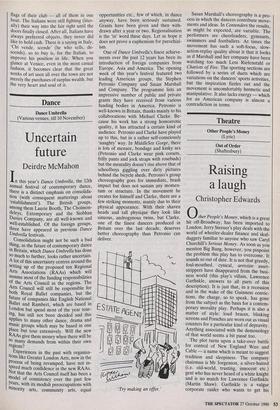Dance
Dance Umbrella (Various venues, till 10 November)
Uncertain future
Deirdre McMahon
In this year's Dance Umbrella, the 12th annual festival of contemporary dance, there is a distinct emphasis on consolida- tion (with consequent mutterings about 'establishment'). The British groups, among them Laurie Booth, The Cholmon- deleys, Extemporary and the Siobhan Davies Company, are all well-known and well-established. Of the foreign groups, three have appeared in previous Dance Umbrella festivals.
Consolidation might not be such a bad thing, as the future of contemporary dance in Britain, which Dance Umbrella has done so much to further, looks rather uncertain. A lot of this uncertainty centres around the setting up of the proposed ten Regional Arts Associations (RAAs) which will assume most of the funding responsibilities of the Arts Council in the regions. The Arts Council will still be responsible for both Royal Ballet companies, but the future of companies like English National Ballet and Rambert, which are based in London but spend most of the year tour- ing, has still not been decided and this applies to many other dance, drama and music groups which may be based in one place but tour extensively. Will the new RAAs give them money when there will be so many demands from within their own regions?
Experiences in the past with organisa- tions like Greater London Arts, now in the Process of being revamped, have not in- spired much confidence in the new RAAs. Not that the Arts Council itself has been a Model of consistency over the past few years, with its modish preoccupations with minority arts, community arts, equal opportunities etc., few of which, in dance anyway, have been seriously sustained. Grants have been given and then with- drawn after a year or two. Regionalisation is the 'in' word these days. Let us hope it does not prove a euphemism for parochial- ism.
One of Dance Umbrella's finest achieve- ments over the past 12 years has been its introduction of foreign companies from Europe, Asia and America. The opening week of this year's festival featured two leading American groups, the Stephen Petronio Company and Susan Marshall and Company. The programme lists an impressive number of public and private grants they have received from various funding bodies in America. Petronio is well-known in Britain, thanks mainly to his collaborations with Michael Clarke. Be- cause his work has a strong homoerotic quality, it has attracted a certain kind of audience. Petronio and Clarke have played up to this, but in a rather self-consciously 'naughty' way. In MiddleSex Gorge, there is lots of menace, bondage and kinky sex (Petronio and Clarke wear pink corsets, frilly pants and jock straps with rosebuds) but the mentality doesn't rise above that of schoolboys giggling over dirty pictures behind the bicycle sheds. Petronio's group choreography goes for immediate, brash impact but does not sustain any momen- tum or structure. In the movement he creates for himself and Clarke, there are a few striking moments, mainly due to their physical appearance. With their shaven heads and tall physique they look like sinuous, androgynous twins, but Clarke, one of the finest dancers produced in Britain over the last decade, deserves better choreography than Petronio can deliver.
'Try making an offer.' Susan Marshall's choreography is a pro- cess in which the dancers contribute move- ments and ideas. In Contenders the results, as might be expected, are variable. The performers are cheerleaders, gymnasts, swimmers and footballers. At times the movement has such a soft-focus, slow- action-replay quality about it that it looks as if Marshall and her company have been watching too much Leni Riefenstahl or Chariots of Fire. The sporting sections are followed by a series of duets which are variations on the dancers' sports activities, but the inspiration fizzles out and the movement is uncomfortably hermetic and manipulative. It also lacks energy — which for an American company is almost a contradiction in terms.


































































 Previous page
Previous page